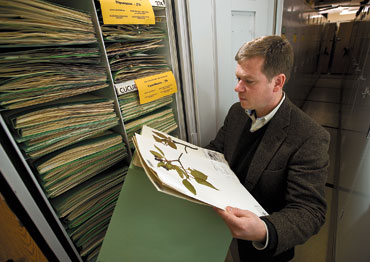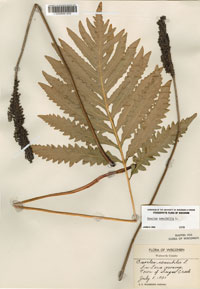Bringing modern roots to a traditional collection
After 10 years in New York City, Ken Cameron was ready for a change.
As the director of the primary molecular research lab at the New York Botanical Garden, Cameron had been working at a world-renowned institution with a first-rate team of botanists and had access to some of the finest resources available. But something was missing.

Ken Cameron, director of the Wisconsin State Herbarium and associate professor of botany, searches through the catalogued plant specimens inside Birge Hall.
Photo: Bryce Richter
“I had one of the greatest jobs in my field … But in the back of my mind I always felt a little unfulfilled, because I like to teach, and I like to interact with students, and I like the academic environment of a university,” he says.
“There were maybe three or four places that if they ever came knocking or if a position opened up I might consider it. And the University of Wisconsin in Madison was one of those places.”
Cameron joined the faculty earlier this year as an associate professor of botany and director of the Wisconsin State Herbarium. He cites the botany department — one of a relative few remaining university botany departments, most having folded into larger biology departments — as a strong draw, along with the mix of teaching, research and administrative duties offered by his joint appointment.
He brought many of his research interests with him, including a specialization in the study and classification of Vanilla and related orchids. He finds this appealing because of their unusual mix of complex and primitive characteristics. While his roots lie in using genetic techniques to decipher plants’ evolutionary relationships, he also has extensive experience working in the field and a deep appreciation of the importance of traditional natural history collections like the herbarium.

A specimen sample of an Onoclea Sensibilis, or Sensitive Fern, from the collection of the Wisconsin State Herbarium inside Birge Hall.
A herbarium is a collection of preserved and catalogued plant specimens, usually pressed and dried, used for research and teaching. “The main purpose is to document plant variation and diversity,” Cameron says. “People often are surprised to find that we don’t just collect one of everything, but in many cases we might have dozens or up to 100 specimens of the same species. The main reason for that is obvious if you considered the human species as an example. You couldn’t define Homo sapiens by one human, you’d have to see the whole range of variation. We do the same with plants — and you’d be surprised how variable [they are].”
UW–Madison’s collection is one of the largest at any public university. Established in 1849, shortly after the university was founded, the Wisconsin State Herbarium contains more than one million specimens of everything from fungi and mosses to grasses and flowering plants — each carefully labeled mounted in a paper folder, and filed in one of the hundreds of cabinets that fill the herbarium’s home in Birge Hall. The herbarium also has an extensive collection of maps, field notes and botanical literature.
Herbaria hearken back to a time when scientific study emphasized natural history collections, which are now largely overshadowed by modern laboratory-based techniques like genetics and molecular biology. But Cameron stresses the importance of combining the modern with the traditional to answer basic questions about plant diversity, relationships and evolution.
“There is a notion that a herbarium is kind of an old-fashioned, dusty-museum kind of a place that maybe doesn’t have relevance in this new modern, molecular age. But I would strongly say that is a false impression,” he says. “The old techniques and tools are just as relevant as the new.”
The historical context offered by the herbarium is also helping studies of contemporary issues such as climate change and the spread of invasive species. “What we’ve done, without thinking about it, is to establish a historical record of which plants were growing where, when they were flowering, and what the land features were like,” Cameron says. “For example, herbarium specimens have been used in the last few years to document climate change. Plants are usually collected when they’re in flower, and by plotting the flowering dates of certain species, especially spring-blooming plants, researchers have been able to show that a lot of our spring wildflowers are blooming progressively earlier and earlier.”
As the herbarium’s uses grow, he is also hoping to expand its audience on campus, throughout the state and even worldwide, by moving many of its resources into a digital domain. As of this summer, the Wisconsin Botanical Information System (WBIS), an online repository of information about the state’s plants, fungi, algae and lichen, now contains data on the herbarium’s entire collection of Wisconsin vascular plants — more than a quarter-million records — plus an additional 87,000 specimens from other herbaria in the state.
With the vascular plant database virtually complete, Cameron and the other herbarium staff are now developing a similar database of their impressive lichen collection. The Wisconsin State Herbarium is also part of a large, multi-institutional project to scan and digitize many of the world’s most valuable plant samples, those known as “type specimens” — the individual physical specimens chosen by scientists to represent their species. Wisconsin’s type images will be combined with those from other institutions to create a standardized online library.
“When I got here, there was already a foot into the 21st century with these databases. My hope is that my legacy will be to expand that online presence and our public presence,” Cameron says. “We’re this gem of an incredible resource tucked away in Birge Hall that very few people in the state realize exists.”


